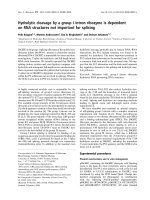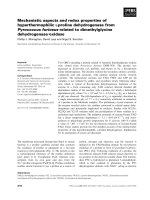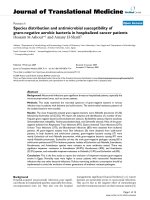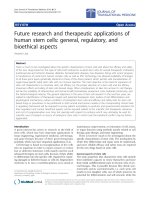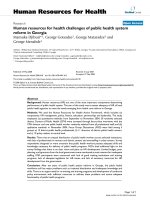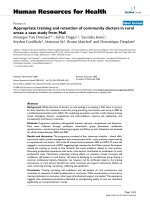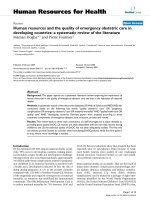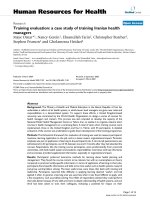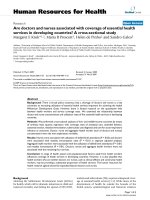Báo cáo sinh học: " Nucleocapsid formation and RNA synthesis of Marburg virus is dependent on two coiled coil motifs in the nucleoprotein" pot
Bạn đang xem bản rút gọn của tài liệu. Xem và tải ngay bản đầy đủ của tài liệu tại đây (415.84 KB, 8 trang )
BioMed Central
Page 1 of 8
(page number not for citation purposes)
Virology Journal
Open Access
Research
Nucleocapsid formation and RNA synthesis of Marburg virus is
dependent on two coiled coil motifs in the nucleoprotein
Andrea DiCarlo
1,2
, Peggy Möller
1,3
, Angelika Lander
1,4
, Larissa Kolesnikova
1,4
and Stephan Becker*
1,4
Address:
1
Philipps-Universität Marburg, Institut für Virologie, Hans Meerwein-Str. 2, 35032 Marburg, Germany,
2
Promega GmbH, High-Tech-
Park, Schildkrötstraße 15, D-68199 Mannheim, Germany,
3
Paul Ehrlich-Institut, Paul-Ehrlich-Str. 51 – 59, 63225 Langen, Germany and
4
Robert
Koch-Institut, Zentrum für Biologische Sicherheit, Berlin, Nordufer 20, 13353 Berlin, Germany
Email: Andrea DiCarlo - ; Peggy Möller - ; Angelika Lander - ;
Larissa Kolesnikova - ; Stephan Becker* -
* Corresponding author
Abstract
The nucleoprotein (NP) of Marburg virus (MARV) is responsible for the encapsidation of viral
genomic RNA and the formation of the helical nucleocapsid precursors that accumulate in
intracellular inclusions in infected cells. To form the large helical MARV nucleocapsid, NP needs to
interact with itself and the viral proteins VP30, VP35 and L, which are also part of the MARV
nucleocapsid. In the present study, a conserved coiled coil motif in the central part of MARV NP
was shown to be an important element for the interactions of NP with itself and VP35, the viral
polymerase cofactor. Additionally, the coiled coil motif was essential for the formation of NP-
induced intracellular inclusions and for the function of NP in the process of transcription and
replication of viral RNA in a minigenome system. Transfer of the coiled coil motif to a reporter
protein was sufficient to mediate interaction of the constructed fusion protein with the N-terminus
of NP. The coiled coil motif is bipartite, constituted by two coiled coils which are separated by a
flexible linker.
Introduction
Marburg virus (MARV) and the closely related Ebola virus
together make up the family of the Filoviridae, which is
classified in the order Mononegavirales. MARV causes a ful-
minant hemorrhagic fever in humans and nonhuman pri-
mates with high fatality rates [1]. To date, neither a
vaccine nor a curative treatment for MARV infection of
humans is available. However, live attenuated recom-
binant vaccines have been described which protected
nonhuman primates against MARV and EBOV infections
[2,3]. These represent promising candidate vaccines for
human use. The recent outbreaks of MARV disease in
Angola and Uganda underline the emerging potential of
this pathogen [4,5].
The MARV particle is composed of seven structural pro-
teins. Four of them, NP, VP35, VP30 and L, form the
nucleocapsid complex of MARV, which surrounds the
viral genome [6]. NP, the major nucleocapsid protein,
self-assembles into tubular nucleocapsid-like structures,
which are mainly found in large intracellular inclusions
[7-9]. Formation of the NP tubular structures is presumed
to be the first step in nucleocapsid assembly. NP interacts
with VP35 which, in turn, interacts with the RNA-depend-
Published: 24 October 2007
Virology Journal 2007, 4:105 doi:10.1186/1743-422X-4-105
Received: 11 September 2007
Accepted: 24 October 2007
This article is available from: />© 2007 DiCarlo et al; licensee BioMed Central Ltd.
This is an Open Access article distributed under the terms of the Creative Commons Attribution License ( />),
which permits unrestricted use, distribution, and reproduction in any medium, provided the original work is properly cited.
Virology Journal 2007, 4:105 />Page 2 of 8
(page number not for citation purposes)
ent RNA polymerase L [6,10]. The complex of VP35 and L
acts as the active RNA-dependent RNA polymerase with
VP35 serving as polymerase cofactor [11]. Additionally, a
trimeric complex was observed consisting of NP, VP35,
and L with VP35 connecting L and NP [6]. Three of the
four nucleocapsid proteins, NP, VP35, and L, are essential
for transcription and replication of the viral RNA [12]. The
fourth nucleocapsid protein, VP30, plays an important
role in viral transcription of the closely related Ebola virus
[11]. For MARV, the role of VP30 is not completely under-
stood at this time. While a minigenome-based transcrip-
tion/replication system did not indicate a requirement for
VP30 in transcription [12], RNAi-based down-regulation
of VP30 expression in MARV infected cells resulted in
decreased levels of all other viral proteins. This suggests a
role for VP30 in replication or transcription.
The self-interaction of NP is the basis for the formation of
the helical nucleocapsid of MARV. Most likely, more than
one homooligomerization domain is necessary to build
the large helices composed of several hundred NP mole-
cules. Additional binding sites on NP mediate interactions
with VP35 and VP30. Mapping of the different interaction
domains on NP is necessary to understand the different
functions of NP during transcription, replication and viral
morphogenesis.
In the present study we show that a predicted coiled coil
motif in NP is critical for the homooligomerization of NP,
formation of NP-induced intracellular inclusions, interac-
tion of NP with VP35 and for the function of NP in RNA
synthesis.
Materials and methods
Cells and cDNA transfections
HeLa, HUH7 and HUH-T7 cells [13] were grown in Dul-
becco's minimal essential medium (Gibco) supplemented
with 10% fetal calf serum, 1% glutamine, and 1% antibi-
otics. Plasmids encoding mutant or wild type MARV pro-
teins were transfected with FuGENE (Roche, Lewes, East
Sussex, U.K.) according to the supplier's protocol. The
minigenome system was set up according to Mühlberger
et al., 1999 [11] with the exception that HUH-T7 cells
were used to constitutively express T7 polymerase instead
of using HeLa cells and infection with MVA-T7.
Plasmids
Internal deletion mutants of NP (accession number: Z12132)
Deletions of the coiled coil motifs (coiled coil 1: aa 320–
348, and coiled coil 2: aa 371–400, coiled coil 1 + 2: aa
320–400) were generated within NP by inverse PCR (Imai
et al., 1991) and pT-NP as template [6]. Plasmids contain-
ing the required mutation were verified by automated
DNA sequencing.
Plasmids encoding NP with sequential deletions of 10
amino acids covering the region 351 – 480 were also gen-
erated by inverse PCR.
C-terminal deletion mutants of NP
Plasmids encoding C-terminal truncated mutants of NP
were generated by insertion of stop codons at the desired
position using the site-direted mutagenesis (Stratagene)
pTM1-C1C2-M-Flag
Sequence encoding the coiled coil regions (residues 321–
400) was amplified by PCR using the plasmid pT-NP. PCR
products were cloned into EcoRI and BamHI restriction
site of the plasmid pTM1-E30m, which encodes an oli-
gomerization-negative Ebola virus VP30 [14]. The
sequence encoding the coiled coil motif was inserted at
the 5'-end of the VP30 gene.
Bacterial expression vectors
Coding sequences of MARV NP and MARV VP35 genes
(accession number: Z12132) were amplified by PCR from
pT-NP and pT-VP35, and cloned into the bacterial expres-
sion vector pGEX-5x-1 (General Electrics, Freiburg, Ger-
many), respectively, using EcoRI restriction site to
generate pGex-NP and pGex-VP35. Sequence of the plas-
mids was confirmed by automated DNA sequencing.
Detailed descriptions of cloning strategies are available on
request.
Glutathione S tranferase (GST) pull-down assay
pGex-NP and pGex-VP35 were transformed into the BL21
strain of E. coli, and expression of the respective proteins
was induced by isopropyl-ß-D-thiogalactopyranoside
(IPTG) at a final concentration of 0.2 mM at 2 h after inoc-
ulation of the bacteria. For background control, the vector
pGEX-5x-1 was transformed in parallel. After 4–5 h of
incubation at 30°C, bacteria were harvested by centrifuga-
tion and washed twice with PBS containing protease
inhibitor cocktail complete™ (2 tablets/ml, Roche, Lewes,
East Sussex, U.K.) and Na-orthovanadate (100 µM). The
final cell pellet was three times frozen/thawed, incubated
on ice for 30 min in buffer 1 (0.5% NP40, 50 mM HEPES,
10% Glycerol, 200 mM NaCl, 0.1% BSA), sonicated (3×
10s at -10°C), incubated for 1 h at 4°C after the addition
of 0.1% Triton ×-100. The suspension was cleared by cen-
trifugation (8,000 rpm, 4°C, 10 min). The supernatant
was incubated with 50% slurry of GSH sepharose beads
(GE-Healthcare, Germany) in presence of 5 mM dithioth-
reitol (DTT) for 90 min in an overhead rotator at 4°C.
Complexes were precipitated, washed twice with ice-cold
PBS and once with buffer 1 supplemented with protease
inhibitors as described above and 5 mM DTT. The final
pellet corresponded to purified GST-NP, GST-VP35, or
GST. Radiolabeled in vitro translation products were incu-
Virology Journal 2007, 4:105 />Page 3 of 8
(page number not for citation purposes)
bated either with purified GST-NP, GST-VP35, or GST in
an overhead rotator for 12 h at 4°C. After two washing
steps with buffer 1 and once with buffer 2 (0.5% NP40, 50
mM HEPES, 10% Glycerol, 500 mM NaCl), sepharose
beads were resuspended in SDS sample buffer and heated
for 5 min at 75°C. All samples were analyzed by 10% SDS
PAGE, subsequent Coomassie blue staining (to visualize
the bacterially expressed proteins) and quantification of
radioactive signals using BioImage analyzer BAS-1000
and the software TINA version 2.0, and Basreader
(Raytest, Freiburg, Germany). The amount of input NP
bound to GST-NP or to GST-VP35 was set to100%.
Marburg virus-specific artificial minigenome system
Functional analyses of mutants of NP were performed
using a MARV-specific minigenome system essentially as
described by Mühlberger et al., [12] with the exception
that instead of HeLa cells, HUH-T7 cells were used which
expressed the T7 DNA-dependent RNA polymerase.
Therefore infection of cells with MVA-T7 was omitted.
Co-immunoprecipitation, in vitro translation,
immunofluorescence analysis
These methods were performed as described by [10].
MVA-T7-driven expression of proteins
This method was performed as described by Becker et al.
[6].
Results
A prerequisite for the formation of filoviral nucleocapsids
is the homooligomerization of NP, which self-assembles
into helical tubules, which are 17 nm in diameter,
observed both in cells expressing recombinant NP and in
MARV infected cells [8,9]. The formation of the large NP-
induced tubules, which are composed of several hundred
NP molecules, most likely requires several homooli-
gomerization domains on NP mediating the helical
arrangement and the accumulation of the individual
tubules into inclusion bodies. In silico analyses of NP
(accession number: Z12132) revealed two stretches of 27
aa in the central part of NP (aa 315 to 400) with a high
probability to form coiled coils (Fig. 1A, [15]). The two
coiled coil motifs are separated by a spacer of 23 aa. Since
coiled coils represent a common protein-protein interac-
tion module, we analyzed whether deletion of the indi-
vidual coiled coil motifs altered the ability of NP to
homooligomerize [16,17]. To this end, sequences encod-
ing either the first (Fig. 1B; ∆C1, aa 320–348), the second
(∆C2, aa 371–400), or both coiled coils (∆C1C2, aa 320
– 400) were removed from the NP-encoding plasmid pT-
NP. The resulting mutants were in vitro translated (Fig.
1C) and were subsequently employed in a GST pull-down
assay using NP fused to GST (GST-NP). We found that
removal of coiled coil 1 (∆C1) had a significant impact on
the binding of NP to itself (Figs. 1D and 1E, ∆C1). The
binding strength was also decreased when both coiled coil
motifs were deleted (Figs. 1D and 1E, ∆C1C2). Deletion
Role of the coiled coil region in NP for NP self interaction, inclusion body formation and MARV-specific transcription/replicationFigure 1
Role of the coiled coil region in NP for NP self inter-
action, inclusion body formation and MARV-specific
transcription/replication. (A) In silico analysis of NP pre-
dicted two coiled coil motifs at aa position 315 to 400 which
are separated by a linker of 23 aa. (B) Schematic presentation
of the constructed mutants of NP with deletions in the coiled
coil region. (C) The constructed plasmids were in vitro
translated, metabolically labeled, separated by SDS-PAGE and
analyzed using a BioImager. (D) In vitro translated and meta-
bolically labeled mutants of NP were incubated with bacteri-
ally expressed GST-NP or GST (negative control).
Complexes were pulled down with glutathion-sepharose,
separated on SDS-PAGE and analyzed using a BioImager.
Binding of NP to GST-NP was set to 100%. (E) Quantification
of 3 separate experiments as shown under (D). (F) Intracellu-
lar distribution of NP and NP∆C1. HUH7 cells were trans-
fected with plasmids encoding NP or NP∆C1 together with a
plasmid encoding T7 polymerase. Cells were fixed with 4%
paraformaldehyde at 18 h post transfection and incubated
with a rabbit anti-NP antiserum. Bound antibodies were
detected with a rhodamine-coupled donkey anti-rabbit anti-
body (NP), and a FITC-coupled donkey anti-rabbit antibody
(NP∆C1). (G) Impact of coiled coils on the function of NP in
a MARV-specific minigenome transcription/replication sys-
tem. MARV nucleocapsid proteins were expressed in
HUHT7 cells together with a MARV specific minigenome. NP
was replaced by the indicated mutants of NP and reporter
gene activity (CAT) was measured. Below the CAT assay,
expression of NP and the NP mutants was confirmed in
Western Blot analysis. +: presence of L. -: absence of L (neg-
ative control). (H) Results of a transcription/replication anal-
ysis using different internal deletion mutants of NP in a
minigenome-based assay (G). +: minigenome system active
(transcription and replication monitored by CAT assay). -:
minigenome system inactive.
A
0,2
0,4
0,6
0,8
1,0
100 200 300 400 500 600
C1 C2
amino acid position
97.5 K
1
2
3
4
5
'C1
NP
'C1C2
MARV
'C2
C
Input
'C1 'C1C2 'C2NP
97.5 K
1
2
3
4
5
6
7
8
9
GST-NP
GST
GST-NP
GST
GST-NP
GST
GST-NP
GST
MARV
Pull down
window 21
0
20
40
60
80
100
ǻC1C2 ǻC1NP
Binding to GST-NP (%)
ǻC2
100
7
77
10
E
Coiled coil probability
transcription
activity
-
-
+
+
+
Coiled Coil 2
H
ǻ371-380
ǻ391-400
ǻ411-420
ǻ421-430
ǻ471-480
D
F
NP 'C1
'C1C2 'C2
+- +- +- +-
12 34 56 7 8
CAT
Į NP
G
L
B
'C1
'C2
'C1C2
NP
300 400
NP
NPǻC1
mock
Virology Journal 2007, 4:105 />Page 4 of 8
(page number not for citation purposes)
of C2 did not significantly impair the homooligomeriza-
tion of NP (Figs. 1D and 1E, ∆C2), suggesting that C1, but
not C2 is essential for intermolecular interaction between
NP molecules.
In MARV infected cells and upon recombinant NP expres-
sion, intracellular inclusion bodies are formed that con-
tain accumulated NP-helices [8]. It was of interest to
determine whether the deletion of C1, which inhibited
NP-NP assembly, influenced the capacity of NP to form
inclusion bodies. NP and NP∆C1 were expressed in
HUH7 cells which were subsequently subjected to
immunofluorescence analysis. While NP expression
induced perinuclear inclusion bodies, expression of NP
lacking C1 (NP∆C1) resulted in homogenous distribution
of NP throughout the cells suggesting that C1 is essential
for accumulation of NP-helices into intracellular inclu-
sions (Fig. 1F).
We next tested whether deletion of the coiled coils inter-
fered with the function of NP in transcription and replica-
tion of the viral RNA [12]. An artificial MARV-specific
transcription/replication system was set up using a CAT
gene-containing MARV-specific minigenome as template
[12]. In this system, NP was replaced by the different
coiled coil mutants and virus-specific transcription was
monitored by CAT activity. In the presence of NP, replica-
tion and transcription of the minigenome system is active
(Fig. 1G, lane 1). Replacement of NP by one of the three
coiled coil mutants abolished virus-specific transcription
(Fig. 1G, lanes 3, 5, 7). This result indicated that deleting
either one or both coiled coil motifs unequivocally abol-
ished the ability of the protein to support viral transcrip-
tion. In a second approach, smaller deletions were
introduced in the region around and inside C2 and the
resulting mutants were tested in the artificial minigenome
system. Two deletions inside C2 were lethal for the func-
tion of the NP (Fig. 1H, ∆371–380, ∆391–400), whereas
mutations downstream of the C2 region did not influence
the function of NP (Fig. 1G). Together, these results indi-
cated that the coiled coil motifs in NP are important struc-
tural elements that support homooligomerization and the
functions of the protein.
Next, we aimed to determine whether the coiled motifs
are sufficient to mediate protein-protein interactions. The
region of the NP gene encoding amino acids 310 to 400
was cloned in frame with a mutant of Ebola virus VP30
(M
Flag
; Fig. 2A, [14]). The fusion protein, named C1C2-
M
Flag
, was coexpressed with the N-terminus of NP
(NP∆441–695), which contains the two coiled coil motifs
(Fig. 2a, Fig. 2B, lane 1). C1C2-M
Flag
was then specifically
precipitated using an anti-Flag antibody; this antibody did
not precipitate the NP N-terminus (Fig. 2B lanes 2 and
11). The precipitation anti-Flag antibody resulted in the
cosedimentation of the NP N-terminus, suggesting that
both proteins were able to interact with each other. How-
ever, when a mouse monoclonal anti-NP antibody (2B10)
was employed in the coimmunoprecipitation, only
NP∆441–695 was precipitated, suggesting that this anti-
body inhibited the interaction of the two proteins (Fig.
2B, lane 3). Control experiments showed that the Flag-
tagged mutant of VP30 (M
Flag
) was unable to interact with
the NP∆441–695 (Fig. 2B, lanes 10 and 11).
The binding site of the monoclonal antibody 2B10 on NP
was analyzed by Western Blot using internal deletion
mutants of NP. From the set of tested NP mutants, the
ones lacking amino acids 391 – 400 and 401 – 410 were
not recognized by 2B10 (Fig. 2C, lanes 2 and 3). Con-
versely, 2B10 recognized a fusion protein containing the
amino acids 391 – 475 fused to EGFP (Fig. 2C, lane 10).
These data indicate that the monoclonal antibody 2B10
epitope is located near the coiled coil motifs. We suggest
that binding of the monoclonal antibody 2B10 inhibited
The coiled coil region in NP is sufficient to mediate interac-tion with NPFigure 2
The coiled coil region in NP is sufficient to mediate interac-
tion with NP. (A) Schematic presentation of the constructed
mutants. The coiled coil region (C1C2, grey boxes) was
fused to an unrelated reporter protein (M
Flag
, striped box).
(B) The mutants were expressed using the MVA-T7 system
in HeLa cells and metabolically labeled using [
35
S]ProMix.
Cells were lysed at 24 h post transfection and cell lysates
precipitated using mouse monoclonal anti-Flag (M2) and/or
mouse monoclonal anti NP (2B10) as indicated. Precipitates
were separated by SDS-PAGE and analyzed using BioImager.
(C) Epitope of the mouse monoclonal antibody 2B10 on NP.
Mutants of NP with sequential deletions of 10 aa were
expressed in HUHT7 cells and cells were lysed at 24 h post
transfection. Cell lysates were separated by SDS-PAGE and
gels blotted onto polyvinylidene fluoride membrane. Mem-
brane was subjected to Western Blot analysis using either
the anti MARV NP mouse monoclonal antibody 2B10 (2B10)
or a rabbit anti MARV nucleocapsid antiserum (α-NC).
C1C2-M
Flag
A
M
Flag
C
N
NP'441-695
N
C
CN
123
C1C2-M
Flag
NP'441-695
B
1
2
3
5
6
7
8
9
DFlag
DFlag
DFlag
2B10
2B10
2B10
C
1
C
2
-
M
F
l
a
g
N
P
'
4
4
1
-
6
9
5
MV
A-
T
7
Mo
c
k
kDa
2B10
DFlag
2B10
DFlag
2B10
DFlag
46
N
P
'
4
4
1
-
6
9
5
M
F
l
a
g
DFlag
DFlag
2B10
C1C2-M
Flag
10 11
NP'441-695
M-Flag
4
1234567891011
NP'391-400
NP'401-10
NP'411-20
NP'421-30
NP'431-40
NP'441-50
NP'471-80
NP'371-400
EGFP-NP391-475
MARV
NP
97,5
66
46
97,5
66
46
kDa
2B10
D-NC
C
Virology Journal 2007, 4:105 />Page 5 of 8
(page number not for citation purposes)
the interaction between the coiled coil motif and the NP
N-terminus by steric hindrance. Taken together, the pre-
sented results suggest that the coiled coil motifs in NP are
necessary and sufficient to mediate protein-protein inter-
action.
We then investigated whether the integrity of the coiled
coil region of NP is important for the binding of NP to the
polymerase cofactor VP35, which connects the polymer-
ase L to the NP-induced helical nucleocapsid [6,10]. The
coding region of VP35 was fused to GST and the fusion
protein (GST-VP35) was expressed in E. Coli and, follow-
ing purification, was incubated with in vitro translated NP
or NP mutants containing deletions of the coiled coil
motifs (Fig. 3A). In a GST pull-down assay, GST-VP35 was
pulled down by glutathione-sepharose and the amount of
coprecipitated NP and mutants of NP was quantified to
assess the interaction of VP35 with the coiled coils (Figs.
3B and 3C). While NP was readily precipitated by GST-
VP35, deletion of C1 significantly decreased the amount
of coprecipitated protein (Figs. 3B and 3C, ∆C1). Deletion
of C2 seemed to increase the binding of GST-VP35 to the
NP mutant (Figs 3B and 3C, ∆C2). These data indicate
that the coiled coil region of NP influences the interaction
with VP35.
To address the question of whether the interaction
domain for VP35 is present in the coiled coil region itself
or whether the coiled coil region is necessary to support
the integrity of the VP35 binding site, we analyzed the
interaction between VP35 and C-terminally truncated NP
mutants (Fig. 4A). NP mutants were in vitro translated
(Fig. 4B) and incubated with the bacterially expressed
fusion protein of VP35 and GST. The resultant complexes
were precipitated with glutathione-sepharose and the
amounts of precipitated NP mutants were quantified by
BioImaging (Figs. 4C and 4D). NP mutants containing the
N-terminal amino acids 1–330, 1–389 and 1–440 showed
only weak binding to GST-VP35 (Fig. 4C. lanes 1, 3, 5, 7
and Fig. 4D). The inclusion of the next 40 amino acids,
which resulted in NP mutant 1–480, increased binding to
GST-VP35 significantly (Fig. 4C, lane 9 and 3D). Further
elongation of the protein, however, diminished binding
of the respective NP mutant to GST-VP35. These results
suggested that the interaction between NP and VP35 is
dependent on the coiled coil region and amino acids 440
to 480.
Taken together, the coiled coil region of NP is essential
and sufficient to mediate the interactions between NP
molecules and is necessary for its interaction with VP35.
Moreover, the presence of the coiled coil domains is
essential for the function of NP in RNA synthesis.
Discussion
Coiled coil motifs are versatile domains that mediate the
interaction of proteins [16]. The central feature of coiled
coil motifs is the presence of repeats of a heptameric
amino acid sequence (heptad repeats, a – to – g) with
hydrophobic residues at the key positions, a and d. The
coiled coils fold into condensed helical structures that are
able to interact, via the amino acids at position a and d,
with another coiled coil in a "knob-into-holes" manner.
This arrangement results in a stable hydrophobic interac-
tion between two coiled coil motifs. Coiled coil motifs are
able to form intra- and intermolecular bonds [18].
Role of the coiled coil region for interaction of NP with VP35Figure 3
Role of the coiled coil region for interaction of NP with
VP35. (A) Mutants of NP (Fig. 1) were in vitro translated and
metabolically labeled with [
35
S]ProMix. Samples were sepa-
rated by SDS-PAGE and analyzed using a BioImager. (B) In
vitro translated and [
35
S]ProMix metabolically labeled
mutants of NP (Fig. 1A) were incubated with bacterially
expressed GST-VP35 or GST (negative control). Complexes
were pulled down with glutathion-sepharose, separated on
SDS-PAGE and analyzed using a BioImager. Binding of NP to
GST-VP35 was set to 100%. (C) Quantification of 3 separate
experiments as shown under (B).
B
97,5
GST-VP35
GST
GST-VP35
GST
GST-VP35
GST
GST-VP35
GST
'C1 'C2
'C1C2
NP
12
3
45
6
78
kDa
A
'C1
'C2
'C1C2
NP
MARV
97,5
66
12 34 5
kDa
Binding to GST-VP35 (%)
50
0
100
150
200
250
NP 'C2'C1C2 'C1
100
16
22
243
NP deletion mutants
C
input
Virology Journal 2007, 4:105 />Page 6 of 8
(page number not for citation purposes)
We have recently reported that homooligomerization of
VP35, the polymerase cofactor, is mediated by a coiled
coil motif which leads to the formation of tetramers [10].
Here we show that the predicted coiled coil domains in
NP, the major MARV nucleocapsid protein, play an essen-
tial role in the formation of NP-NP oligomers and the for-
mation of inclusion bodies which contain preformed NP-
induced nucleocapsid-like structures [8]. The nucleopro-
tein of Ebola virus also contains a region, encompassing
amino acids 334 to 363, which has a very high probability
to form a coiled coil structure (Fig. 5A). The predicted
coiled coil in Ebola virus NP corresponds to the predicted
coiled coil C1 of MARV NP. Seven of the nine key residues
of C1 are conserved between MARV and ZEBOV (Fig. 5B).
Interestingly, the second coiled coil predicted in MARV
NP (amino acid positions 371 – 400) is less conserved in
Ebola virus NP (Fig. 5B).
The presence of C1 is essential for the formation of the
NP-NP and the NP-VP35 complex, while removal of C2
has only a mild inhibitory effect in the case of NP-NP
complex formation and it even enhances binding in the
case of the NP-VP35 interaction. On the other hand, C2 is
essential for the function of NP in transcription/replica-
tion. Sequential 10 amino acid deletions both inside and
outside of coiled coil motif C2 underline this result by
revealing that only deletions inside C2 abolished the
function of NP (Fig. 1H). These results support the follow-
ing hypothesis. The two coiled coil motifs are involved in
intra- and intermolecular binding. While C1 is involved in
intermolecular binding between NP molecules and sup-
ports binding of NP and VP35, the second coiled coil
motif (C2) mediates an intramolecular interaction with
C1. The intramolecular interaction might be involved in
regulating binding between NP and VP35 (binding is
enhanced in the absence of C2) and is essential for the
function of NP in transcription and replication of MARV
RNA.
It is possible that the conformational flexibility of NP,
which allows for both intra- and intermolecular binding,
is a prerequisite for NP to perform its multiple tasks in
RNA synthesis and nucleocapsid morphogenesis. This
concept is supported by characterization of the Hantavi-
rus NP. Alfadhli et al. showed that the predicted coiled
coil in Hantavirus NP facilitates intramolecular binding
via a helix turn helix structure at low concentrations, while
it facilitates intermolecular binding at high concentra-
tions [18]. Additionally, the 3D structure of the vesicular
stomatitis virus nucleocapsid protein complexed to RNA
suggests that the conformation of the nucleocapsid pro-
tein must undergo changes to allow the polymerase com-
plex access to the RNA [19].
The formation of complex helical structures composed of
hundreds of proteins is only possible if several homotypic
interaction domains are available that allow the sequen-
tial ordered arrangement of the molecules. Homooli-
gomerization of NP via the coiled coil motif in a central
region of NP does not exclude the presence of other
homooligomerization domains in the protein. To that
end, Watanabe et al. presented data for Ebola virus show-
ing that the presence of the C-terminal 150 amino acids of
NP is necessary for the formation of the helical nucleocap-
sids [20]. It might be that the coiled coil-mediated bind-
ing of NP molecules to each other is only one step in the
formation of the helix which is then followed by or
accompanied by interactions with other parts of NP.
For other viruses of the order Mononegavirales, Sendai
virus and measles virus, a conserved central part of NP has
been found to be necessary for homooligomerization of
NP [21-23]. Interestingly, the respective regions in NP or
N proteins do not have a high probability of forming
coiled coil structures.
In this study, we have shown that two predicted coiled
coil motifs in NP of MARV are important structural ele-
ments for NP-NP and NP-VP35 interactions and the for-
mation of inclusions induced by NP. The coiled coil
motifs can be transferred to an unrelated reporter protein
and are sufficient to mediate the interaction between the
Mapping of regions on NP involved in binding to VP35Figure 4
Mapping of regions on NP involved in binding to VP35. (A)
Schematic presentation of the constructed mutants of NP
with C-terminal truncations. (B) The constructed plasmids
were in vitro translated, metabolically labeled using
[
35
S]ProMix, separated by SDS-PAGE and analyzed using a
BioImager. (C) In vitro translated and metabolically labeled
mutants of NP were incubated with bacterially expressed
GST-VP35 or GST (negative control). Complexes were
pulled down with glutathion-sepharose, separated on SDS
PAGE and analyzed using a BioImager. Binding of NP to GST-
VP35 was set to 100%. (D) Quantification of 3 separate
experiments as shown under (C).
NP 579
NP 330
NP 389
NP 440
NP 480
NP 521
NP
A
B
1234567
NP 330
NP 389
NP 440
NP 481
NP 521
NP 579
NP
97,5
46
30
kDa
C
D
Binding to GST-VP35 (%)
0
40
80
100
140
180
200
160
120
60
20
NP 330
NP 389
NP 440
NP 481
NP 521
NP 579
NP
GST-VP35
GST
GST-VP35
GST
GST-VP35
GST
GST-VP35
GST
GST-VP35
GST
GST-VP35
GST
GST-VP35
GST
123 4 5 6 7 891011121314
97,5
46
30
kDa
NP 330
NP 389
NP 440
NP 481
NP 521
NP 579
NP
input
Virology Journal 2007, 4:105 />Page 7 of 8
(page number not for citation purposes)
reporter protein and NP. Moreover, both motifs are essen-
tial for the function of NP during transcription and repli-
cation.
Acknowledgements
The authors wish to acknowledge expert technical assistance by Ulla
Thiesen. Financial support came from the Deutsche Forschungsgemein-
schaft SFB 593 and SFB 535.
References
1. Martini GA, Kanuff HG, Schmidt HA, Mayer G, Baltzer G: Über eine
bisher unbekannte, von Affen übertragene Viruserkrankung:
Marburg-VirusKrankheit. Dtsch Med Wochenschr 1968,
93:559-571.
2. Daddario-DiCaprio KM, Geisbert TW, Stroher U, Geisbert JB, Grolla
A, Fritz EA, Fernando L, Kagan E, Jahrling PB, Hensley LE, Jones SM,
Feldmann H: Postexposure protection against Marburg haem-
orrhagic fever with recombinant vesicular stomatitis virus
vectors in non-human primates: an efficacy assessment. Lan-
cet 2006, 367:1399-1404.
3. Jones SM, Feldmann H, Stroher U, Geisbert JB, Fernando L, Grolla A,
Klenk HD, Sullivan NJ, Volchkov VE, Fritz EA, Daddario KM, Hensley
LE, Jahrling PB, Geisbert TW: Live attenuated recombinant vac-
cine protects nonhuman primates against Ebola and Mar-
burg viruses. Nat Med 2005, 11:786-790.
4. CDC: Outbreak of Marburg Virus Hemorrhagic Fever –
Angola, Ocotber 1, 2004-March 29, 2005. MMWR, Morbidity and
Mortality Weekly Report 2005, 54:.
5. WHO: Marburg haemorrhagic fever in Uganda. Epidemic and
Pandemic Alert and Response (EPR) 2007.
6. Becker S, Rinne C, Hofsäss U, Klenk H-D, Mühlberger E: Interac-
tions of Marburg virus nucleocapsid proteins. Virology 1998,
249:406-417.
7. Becker S, Huppertz S, Klenk HD, Feldmann H: The nucleoprotein
of Marburg virus is phosphorylated. J Gen Virol 1994, 75(Pt
4):809-818.
8. Kolesnikova L, Mühlberger E, Ryabchikova E, Becker S: Ultrastruc-
tural organization of recombinant Marburg virus nucleopro-
tein: comparison with Marburg virus inclusions. J Virol 2000,
74:3899-3904.
9. Mavrakis M, Kolesnikova L, Schoehn GBS, Ruigrok RWH: Morphol-
ogy of Marburg virus NP-RNA. Virology 2002, 296:300-307.
10. Möller P, Pariente N, Klenk HD, Becker S: Homo-oligomerization
of Marburgvirus VP35 is essential for its function in replica-
tion and transcription. J Virol 2005, 79:14876-14886.
11. Mühlberger E, Weik M, Volchkov VE, Klenk H-D, Becker S: Com-
parison of the transcription and replication strategies of
marburg virus and Ebola virus by using artificial replication
systems. J Virol 1999, 73:2333-2342.
12. Mühlberger E, Lotfering B, Klenk H-D, Becker S: Three of the four
nucleocapsid proteins of Marburg virus, NP, VP35, and L, are
sufficient to mediate replication and transcription of Mar-
burg virus-specific monocistronic minigenomes. J Virol 1998,
72:8756-8764.
13. Schultz DE, Honda M, Whetter LE, McKnight KL, Lemon SM: Muta-
tions within the 5' nontranslated RNA of cell culture-
adapted hepatitis A virus which enhance cap-independent
translation in cultured African green monkey kidney cells. J
Virol 1996, 70:1041-1049.
14. Hartlieb B, Modrof J, Mühlberger E, Klenk HD, Becker S: Oligomer-
ization of Ebola virus VP30 is essential for viral transcription
and can be inhibited by a synthetic peptide. J Biol Chem 2003,
278:41830-41836.
15. Lupas A, Van Dyke M, Stock J: Predicting coiled coils from pro-
tein sequences. Science 1991, 252:1162-1164.
16. Burkhard P, Stetefeld J, Strelkov SV: Coiled coils: a highly versatile
protein folding motif. Trends Cell Biol 2001, 11:82-88.
17. Cohen C, Parry DA: Alpha-helical coiled coils: more facts and
better predictions. Science 1994, 263:488-489.
18. Alfadhli A, Steel E, Finlay L, Bachinger HP, Barklis E: Hantavirus
Nucleocapsid Protein Coiled-Coil Domains. J Biol Chem 2002,
277:27103-27108.
19. Green TJ, Zhang X, Wertz GW, Luo M: Structure of the vesicular
stomatitis virus nucleoprotein-RNA complex. Science 2006,
313:357-360.
20. Watanabe S, Noda T, Kawaoka Y: Functional mapping of the
nucleoprotein of Ebola virus. J Virol 2006, 80:3743-3751.
21. Myers TM, Pieters A, Moyer SA: A highly conserved region of the
Sendai virus nucleocapsid protein contributes to the NP-NP
binding domain. Virology 1997, 229:322-335.
22. Bankamp B, Horikami SM, Thompson PD, Huber M, Billeter M, Moyer
SA: Domains of the measles virus N protein required for
Coiled coil motif in Zaire Ebola virus NP (A) In silico analysis of EBOV NP predicted one coiled coil motifs at aa position 333 to 367Figure 5
Coiled coil motif in Zaire Ebola virus NP (A) In silico analysis of EBOV NP predicted one coiled coil motifs at aa position 333
to 367. (B) Alignment of the coiled coil regions in NP of filoviruses. C1: coiled coil motif 1, C2: coiled coil motif 2. Linker:
Sequence without coiled coil prediction. a, d: Key positions in the heptad repeats of MARV NP. Large boxes: conserved amino
acids at the coiled coil key positions. Small boxes: Key positions in MARV NP without conservation in Ebola virus NP.
100 200 300 400 500 600
amino acid position
window 21
Coiled coil probability
700
0,2
0,4
0,6
0,8
1,0
315
VNVGEQYQQLREAAHDAEVKLQRRHEHQEIQAIAEDDEERKILEQFHLQKTEITHSQTLAVLSQKREKLARLAAEIENNIVEDQG
400
333
VNVGEQYQQLREAATEAEKQLQQYAESRELDHLGLDDQEKKILMNFHQKKNEISFQQTNAMVTLRKERLAKLTEAITAASLPKTS
418
V
V
Y
Y
QL
QL
A
A
A
A
KL
QL
G
G
ad ad ad ad
L
A
L
RE
L
L
AA
I
I
I
V
ad ad ad a
RR
linker
C2C1
A
B
MARV NP
EBOV NP
Publish with BioMed Central and every
scientist can read your work free of charge
"BioMed Central will be the most significant development for
disseminating the results of biomedical research in our lifetime."
Sir Paul Nurse, Cancer Research UK
Your research papers will be:
available free of charge to the entire biomedical community
peer reviewed and published immediately upon acceptance
cited in PubMed and archived on PubMed Central
yours — you keep the copyright
Submit your manuscript here:
/>BioMedcentral
Virology Journal 2007, 4:105 />Page 8 of 8
(page number not for citation purposes)
binding to P protein and self-assembly. Virology 1996,
216:272-277.
23. Liston P, Batal R, DiFlumeri C, Briedis DJ: Protein interaction
domains of the measles virus nucleocapsid protein (NP). Arch
Virol 1997, 142:305-321.
